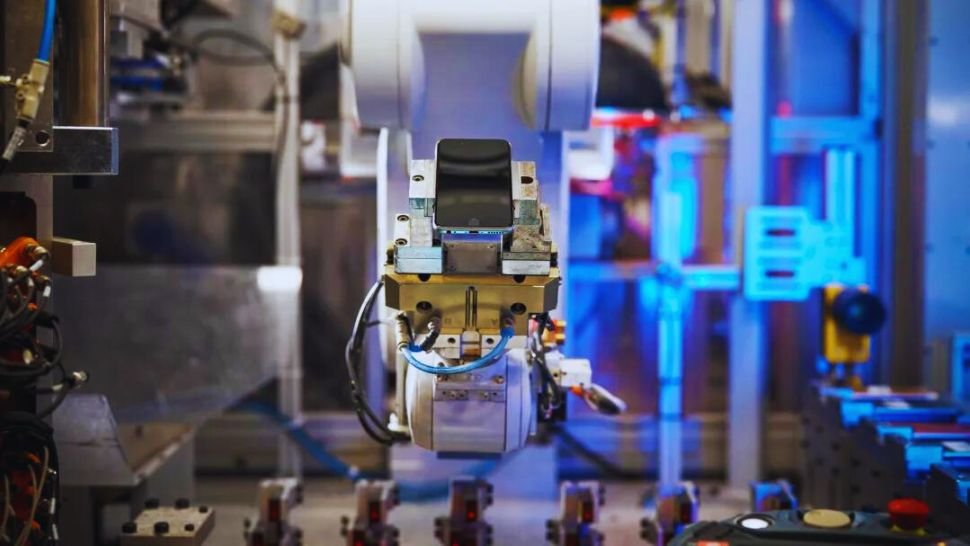Apple May Make Its Own iPhone Batteries has an inclination towards in-house hardware development and has achieved considerable success in this regard, as evidenced by the A- and M-series CPUs. What’s the next item on the list of DIY components? According to a recent report, iPhones could be powered by Apple-manufactured batteries as early as 2025.

Korean news outlet ET News reported this information citing multiple business sources. It appears that Apple is directly involved in the creation of the new battery pack; in fact, they are even directing the selection of materials used in the individual components of the battery. According to reports, the aim is to provide “much better performance than the existing one.”
Apple May Make Its Own iPhone Batteries
According to ET News, Apple’s primary objective is to use the new batteries in iPhones, which are the company’s flagship product. As a result, these batteries could appear in upcoming iPads and MacBooks.

In other words, the iPhone 17 could have a lot more battery life than the iPhone 15. Not only would that make buying the iPhone 16 less appealing, but any significant increase in battery life would be interesting to see, especially considering that the iPhone 15 Plus and iPhone 15 Pro Max have some of the best phone battery life available.
In our detailed battery life tests, the phones recorded times of 14 hours, 14 minutes and 14 hours, 2 minutes, respectively. Meanwhile, the iPhone 15 and iPhone 15 Pro were rated at 11 hours, 5 minutes and 10 hours, 53 minutes. While that’s not enough to rank among the phones with the longest battery life, it’s significantly faster than the average time for smartphones in our tests; more importantly, it beats the times reported by competitors like the Google Pixel 8 and Samsung Galaxy S23.
According to Apple’s research on battery materials, materials are selected to maximize battery performance, energy density, power output, and stability. According to rumors, Apple is planning to create a battery that has “never been in commercial use worldwide” in an effort to become a leader in battery material innovation.
Increasing the size of the battery has historically been the biggest way to increase battery life, although this is not always simple. Larger batteries require more space, which increases the weight and thickness of the phone. It has been found that increasing the energy efficiency of the phone is quite beneficial. Using “stacked” batteries has also been discussed to increase battery capacity without taking up extra space.
Reinventing the battery may seem like a very difficult task. It will be interesting to see what Apple can achieve by getting more involved in the creation of new batteries, however, given the progress it has achieved by creating its own CPUs. You can also be sure that other battery manufacturers will attempt to replicate Apple’s achievement if the company achieves a breakthrough.
Hopefully Apple can meet the 2025 deadline and avoid becoming obsolete like the much-anticipated Apple 5G modem. Even after years of rumors, that’s not expected to happen until at least 2027.
iRecycle
Obviously, a wide variety of materials are used to make phones and computers, so Apple’s recycling announcement is about more than just cobalt. The business has said it intends to use recycled materials for the tin soldering and gold plating used for its circuit boards by 2025, in addition to using recycled rare-earth elements in its magnets (such as those that let your watch and phone charge wirelessly).

However, the fact that cobalt is a key ingredient is probably not coincidental. In the name of a clean-energy economy, this metal has come to represent all the potential harm that mining can cause. Cobalt is a critical component of lithium-ion batteries and is currently mined primarily in the Democratic Republic of Congo, where the industry has been linked to human rights violations, including forced labor. If you’re interested in learning more, there’s a new book and a great story in the New Yorker from 2021 about this.
Apple has increased the percentage of recycled cobalt in batteries from 13% in 2021 to more than 25% by 2022. Also, according to the latest announcement, all cobalt used in “Apple-designed batteries” will come from recycled sources in a few years. A quick note here: I reached out to Apple on some other news-related questions and to find out how much cobalt it will use in total. I haven’t yet heard back from the company.
Around Here
When discussing materials for clean energy many people talk about a “circular economy,” in which discarded batteries from old electric vehicles can be recycled to make new batteries, requiring little or no new material mining. For that to happen you would need almost as many batteries on the figurative off-ramp as are entering the on-ramp. And that’s just not happening.

In case you didn’t know, electric cars are on the rise in popularity. In 2017, EVs accounted for a little over 1% of all new cars sold worldwide. By 2022, just five years later, the International Energy Agency reports that percentage will have grown to nearly 13%. For some time to come, we should expect to see an increase in the number of EVs on the road every year, especially as more and more countries enact legislation supporting EV use globally.
While the rapid adoption of EVs is great for the fight against climate change, it presents a challenging situation for battery recyclers.
The batteries used in cars have a lifespan of over ten years, and can last even longer if they are repurposed for stationary energy storage. Thus, in most circumstances, EV batteries will not be suitable for recycling for at least 15 years. 15 years ago, in 2008, the Tesla Roadster was just starting to be produced, and for the first few years the firm was only making a few hundred per year. To put it simply, not many EVs are being taken off the road today because they are old, and that is unlikely to happen for some time.
Thus, as the EV market grows rapidly, there will be a shortage of recycled materials. For example, if every EV and phone manufacturer used only recycled cobalt, there would not be enough cobalt.
One more thing
Slowing climate change and catching up with what is already happening is challenging and complex. What if we try to reduce some of the global warming that has already been brought about? According to some researchers, it is at least an attractive enough concept to investigate.
Given that sweeping initiatives, or even just studies of potential impacts, have the potential to dramatically change people’s lives around the world, geoengineering is inherently controversial. Furthermore, what benefits some people may not benefit others. Some organizations are trying to include a more diverse range of views in the discussions, especially from countries most at risk from climate change.
In an effort to publicize who’s participating in the geoengineering debate, my colleague James Temple took a look at some of the organizations. Check out more in his informative story.
Also Read:- Google and Samsung in a tussle over Gemini AI on Z Fold 6 and S24
Also Read:- iPhone 15 Pro Max Review











2 thoughts on “Apple May Make Its Own iPhone Batteries – Starting With the iPhone 17”